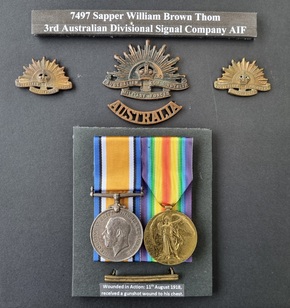THOM, William Brown
| Service Number: | 7497 |
|---|---|
| Enlisted: | Not yet discovered |
| Last Rank: | Sapper |
| Last Unit: | 1st Divisional Signal Company |
| Born: | Crindledyke, Scotland, 1887 |
| Home Town: | Not yet discovered |
| Schooling: | Not yet discovered |
| Occupation: | Stonemason |
| Memorials: |
World War 1 Service
| 1 Apr 1916: | Involvement Sapper, 7497, 1st Divisional Signal Company, --- :embarkation_roll: roll_number: '6' embarkation_place: Sydney embarkation_ship: SS Makarini embarkation_ship_number: '' public_note: '' | |
|---|---|---|
| 1 Apr 1916: | Embarked Sapper, 7497, 1st Divisional Signal Company, SS Makarini, Sydney |
Help us honour William Brown Thom's service by contributing information, stories, and images so that they can be preserved for future generations.
Add my storyBiography contributed by Kerry Bulow
William Thom was born in Crindledyke, Scotland, in 1887. He is believed to be the son of John Thom, a stonemason, and Margaret Brown. At the commencement of the First World War, he was residing in Sydney, New South Wales. On 24 January 1916, he joined the Australian Imperial Force (AIF), listing his profession as a stonemason. He provided his address as 125 St Johns Road, Glebe, Sydney, and designated his mother, Margaret Thom, living at 80 Cromwell Road, Crosshill, Glasgow, as his next of kin.
Following his initial training, he sailed as a sapper aboard the SS Makarini, departing with the 16th reinforcements of the 1st Divisional Signal Company on 1 April, bound for Egypt. Upon his arrival in Suez, he reported to the Engineer Training Depot, Signal Section at Tel El Kebir on 4 May. After completing specialized training in signals, he set sail for the United Kingdom at the end of that month. According to his service record, on 16 July, he was admitted to the General Hospital at Bulford with a septic wound on his leg. This entry was later corrected to state that he was admitted because of venereal disease. After ten days, he rejoined his unit stationed at Parkhouse. In September, he joined the Engineer Training Depot, Signals Section located in Hitchen, where he stayed until December 1917, at which point he departed for France with his unit.
Upon arrival, he reported to the Royal Engineers Signals Service Depot at Abbeville on 17 December and then joined the 3rd Divisional Signal Company four days later while they were at Ravelsburg. The Division was ordered to return to the line on this day, taking over a sector from Armentieres to Bois Grenier. The following day, headquarters was set up at Steenwerck. The weather at this time was described as freezing, with frost encrusted on trees and fences and the landscape almost entirely white with ice crystals. The company remained at this location, and on Christmas day, 25 December, it was snowing with strong gusty winds; however, the Christmas festival was observed as far as possible throughout the unit. In March 1918, the Germans launched their Spring Offensive near Saint-Quentin, and as the Allied line collapsed, the German forces advanced into the Somme valley. Sapper Thom was involved in this fighting during the First Battle of Morlancourt, where the Germans seriously attempted to penetrate the line around Sailly-Laurette. During the Hundred Days Offensive on 8 August around Amiens, the Division was tasked with leading the Australian Corps part in the attack. During this fighting, Sapper Thom was wounded in action on 11 August and was sent to the 55th Casualty Clearing Station with a gunshot wound to his chest. He was transferred to a hospital in Rouen before being evacuated to the United Kingdom via a hospital ship.
He was admitted into the Kitchener Military Hospital at Brighton, and following a period of care, he was discharged to furlough; then, from 13 September, he was moved to the No 1 Convalescent depot at Sutton Veny. Sapper Thom reported to the Overseas Training Brigade on 3 October but remained in the United Kingdom. While on leave, he was admitted to the 4th Scottish General Hospital in Glasgow due to influenza; it is thought that he had been visiting family. Sapper Thom spent the rest of the war in and out of hospital, and on 27 January 1919, he was charged with AWL. After being found guilty, he received 7 days of confinement to barracks and forfeited one day's pay. On 5 February, he reported to the No 2 Command Depot at Weymouth, and he was granted leave from 17 May until 30 September to take up temporary employment in concreting. He was eventually returned to Australia on board HT Ascanius and disembarked in Sydney on 10 November. His appointment in the AIF was terminated on 2 January 1920.
He first appears on the Australian Electoral Roll in 1930, living in Coney Road, Earlwood, New South Wales, working as a stonemason. By 1936, he was living in Gosford, New South Wales, and he was employed as a gardener. By 1943, he had returned to his former occupation as a stonemason. The 1949 Electoral Roll lists him residing at 125 Hargrave Street, Paddington, and is now employed as a painter and docker, and he lived at this address until at least 1954.
It is believed that he never married and passed away in Balmain, New South Wales, in 1957 (NSW Registration Number 18114/1957). It hasn't been discovered where he was buried.










